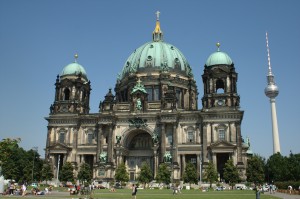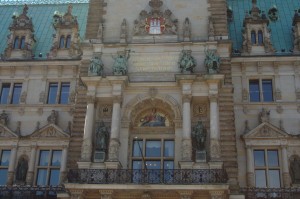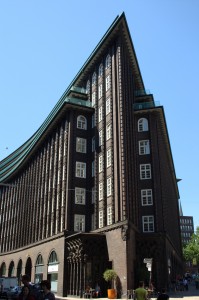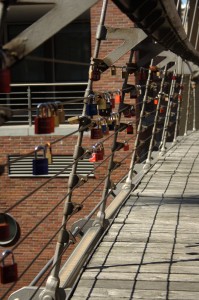We got into Berlin in the early afternoon, and after navigating the U-Bahn metro found ourselves on Adalbertstraße in the Kreuzberg district. We had no idea how to find our hostel since it seemed to be hidden and the street numbering system in Berlin is different to that of the UK. We walked quite far down the street which seemed to grow increasingly seedier, reminiscent of Hamburg. We eventually found the amusingly named ‘Comebackpackers’ who assured us that the area was in fact safe.
Our room was a 16-bed dorm, with a 13-3 female to male ratio. This is actually a good thing as it usually leads to much less snoring. Another plus was that the Wifi in this hostel actually worked. We had a fairly quiet evening drinking €5 bottles of wine on the terrace with some Canadian and Mancunian girls from our dorm.
Next day we awoke to sweltering heat and decided to make our way to the Sandeman’s tour of Berlin, starting from the Brandenburg Gate. After scratching our heads at the U-Bahn and S-Bahn for a bit we found it, walking past the huge US embassy on the way. There were a lot of tat-touting street vendors in Parisienplatz (in front of the Brandenburg Gate) including men in faux Cold War US Army and West German military uniforms inviting you to pose with their flags for photos. Also bemusingly a woman dressed in a full gorilla costume with flip flops showing underneath, in 38C weather.
At Parisienplatz (the French embassy is on the square) we were given a sample of German humour as the tour guide showed us the statue of ‘Victoria’. It was restored after being stolen by Napoleon with its head altered to look down on the French embassy. The joke is in the name, and we were reliably assured by our American-Finnish guide that German humour did exist but was not funny.
We also saw the Hotel Adlon, where Michael Jackson famously dangled his baby from the Royal Suite window. Our guide had looked into staying in the suite, also used by Queen Elizabeth II, and told us it was €15,000 a night. We then walked along Ebertstraße to the Holocaust Memorial, which is a huge area filled with variously sized concrete blocks. The artist did not reveal any meaning behind the number or pattern of the blocks. Walking into the memorial, which dips into a valley in the centre, is very peaceful as traffic noise is blocked out. I liked the memorial as it is intended to allow more individual interpretation than traditional memorials to the 6 million Jews murdered by the Nazis. 6 million is very hard to comprehend as a number alone since it is so large.
Next we walked to the site of the Führerbunker, which is now underneath a car park. The bunker was blown up multiple times after the war and is now inaccessible. I found it very strange thinking that only 67 years ago the city was in ruins and rumbling with tanks. On the sides of one or two surviving older buildings I noticed bullet holes in the stone. Many of the ‘old’ buildings had to be extensively rebuilt after 1945.
In the sweltering heat we walked to the former site of the Gestapo headquarters, which is now a museum called the ‘Topography of Terrors’. There is a large section of the Berlin Wall, ironically protected by a fence, adjacent to it. The former site of the Berlin Wall (there were actually two, with a ‘death strip’ in the middle) is marked with twin paving stones. It follows a zigzagging path across the city.  Then we trudged on to Checkpoint Charlie, which has a replica border crossing booth, large photos of American and Soviet soldiers on their respective former sides, and its own whole range of Berlin Wall tourist tat such as fake Soviet hats and passport visa stamping.
Then we trudged on to Checkpoint Charlie, which has a replica border crossing booth, large photos of American and Soviet soldiers on their respective former sides, and its own whole range of Berlin Wall tourist tat such as fake Soviet hats and passport visa stamping.
We (from many places in Berlin) saw the television tower on Alexanderplatz, which is the tallest structure in Germany. It was built in the 60s and was intended as a show of force for the secular East German government. Unfortunately for them, a reflection dubbed the “Pope's Revenge” by Berliners thwarts their secular building ambitions quite spectacularly.

Berlin Part 1 - Comments
We arrived in Hamburg and asked the miraculously available information man if he knew where our hostel (the ‘Generator’) was. After dumping our stuff, we wandered down the nearest street looking for an Internet café (broken hostel Wifi is a running theme). What we did find was seediness in all directions, and decided rather soon to turn around. Finally we took refuge in a café next to a Polizei station.

We didn’t do much on the first night, but next day went on our first Sandemans walking tour. The guide was very enthusiastic and obviously very interested in the history of Hamburg, which has a florid past as a trading centre, being a member of the Hanseatic League. It has been hit by several disasters over the centuries, including a Great Fire in 1842, the black death in 1350, and Allied bombing in World War II which killed around 50,000 people and destroyed many buildings. Nevertheless, there are a great number of old and beautiful buildings plus some examples of ‘brick expressionism’.
The Chilehaus was built in 1922 by a shipping magnate who traded with, unsurprisingly, Chile. The building is very unusual, featuring idealised depictions of Chilean life and the sharpest corner of a building in Europe.  We also walked past the former headquarters of Degesch, who manufactured the infamous Zyklon B. Even before we knew its history we thought it very imposing.
We also walked past the former headquarters of Degesch, who manufactured the infamous Zyklon B. Even before we knew its history we thought it very imposing.
We were also alerted to the presence of ‘stumbling stones’ which are dotted throughout cities in Germany. They are slightly raised brass plaques which each feature the name and vital dates of a victim of the Holocaust. It is a different form of memorial that people might come across by tripping.
It was comforting to find that it is not only the UK that is profligate with public money. The Elbe Philharmonic, while a very grand and modern project, is now many years and euros over the initial estimate. We were advised to ask Hamburgers what they thought of it if we wanted some explosive reactions. We also heard the amusing tale of Klaus Störtebeker, the fisherman turned pirate and perhaps a German answer to Robin Hood. Our guide’s story-telling prowess is too great to try and replicate here so I will recommend you take the tour!
One last interesting thing we saw on the tour was a lot of padlocks attached to a bridge. I asked the tour guide what they were about and he replied that they are put there every Valentine’s day by young lovers, who then throw the key into the river below as a symbol of their commitment to each other. If you click on the photo you can see many have names and dates engraved in them. This was only slightly soured by the fact that before each next Valentine’s day the city council cuts some of them off to make room for more.

In the evening we went in search of cheap but good restaurants, and found the Portuguese quarter on a recommendation from the tour guide. The outside table we wanted got stolen from under our noses by smug and non-queueing people, but we decided to go into Casa Ricardo (in fact Spanish) on Rambachstraße anyway. Mixed tapas for €23 shared sounded and tasted good. It had very kingly prawns, deep fried anchovies, calamari rings, potatoes, crab claws, Spanish chorizo and new potatoes. While veteran eaters, we had anticipated a rather smaller portion and were also duty bound to work through the starter tapas of spicy meatballs and diced potatoes in lovely chilli tomato sauce.
The bill (zahlen) was requested with a little dread, as €23 shared now seemed rather too good to be true for our banquet. Fortunately we were wrong, and got the most surprising bill of just €45 for two drinks each, two starters and the aforementioned main! If you ever go to Hamburg, go to this restaurant!
Hamburg was a great place once we found our way out of the dodgy bit by the station. Even though we were there early in the week and so did not get a glimpse of the famously decadent Reeperbahn, it was one of our favourite places. It is not too busy or dirty and our hostel (Generator) was cheap and good. The only blip was the windows being locked in our 6th floor dormitory due to people throwing things out. This was rather stifling in the sunburn inducing heat, but I guess being British I can’t complain about good weather. Onwards to Berlin aboard the super-efficient 2-hour Deutsche Bahn ICE train!
Hamburg - Comments
Lucy and I have just begun our first Interrail trip. We flew out from Gatwick to Copenhagen yesterday following a less than perfect night’s sleep on the terminal floor. Perhaps bringing sleeping bags (for a hostel trip) would have been worth it after all.
The man at the tourist information desk spoke impeccable English with a curious hint of a Birmingham accent. He told us that the street we were staying on, Struenseegade (stroont-see-girder) is named after a German doctor who was beheaded for getting a little bit too close to the queen. We withdrew the grand sum of 300 Danish kroner, thinking this would be more than enough for the time we were going to spend in Copenhagen. This turned out to be a little optimistic as we eventually spent 2500.
We had lunch in a cafe laconically named ‘ñ’. It is a vegetarian place and we both had a bedazzling varied Brunch with freshly squeezed orange juice (the Danes don’t seem to drink any other type). It came in at a pretty reasonable price and their wifi worked well, unlike the hostel’s.

Later we went to the Tivoli amusement park, this had a lot of rides ranging from rollercoasters to Hans Christian Andersen moving exhibitions. My favourite was the ‘Daemon’, a very red rollercoaster with loops and corkscrews. We also went on several rides involving spinning around and water which were naturally enjoyable. The most adrenaline fuelled ride we went on was a vertical drop which first moved very, very high with enthusiastic steam noises. From the top we could see a long way around us, accompanied by the musings of a man wondering why he had gone on the ride. Shortly afterwards, we fell fast enough to cause significant g-force and a lot of screaming from Lucy.
We also noticed that bicycles are incredibly popular in the entirely flat Copenhagen. Perhaps due to this, the Danish are almost all very slim and attractive, with the (unusual for England) combination of blue eyes and dark hair. Copenhagen is a very peaceful city, with comparatively few cars to anywhere in the UK. We are now aboard an ICE (InterCity Express) train to Hamburg, which drove onto a ferry and provided a nice break as we had to go above decks. We spent the train journey talking to friendly Germans, which made it go very quickly. We now look forward to finding a hostel which we know only the name of, having deigned to not bother printing out the reservation slip.
Copenhagen - Comments
Description
This script watches for Windows drive letter connection or disconnection events and allows scheduling of tasks to run accordingly. For example, this is useful if you want to run a program to synchronise the contents of a USB pen drive automatically when it is inserted.
Tasks can be configured in a human-readable JSON format configuration file. It installs itself as a service and is very, very alpha.
Requirements
- The script should work in Python >= 2.6 and requires pywin32.
- It has been tested on Windows 7 x64 only.
Source code repository: https://github.com/inversion/drive-letter-watcher
Run task on drive connection or disconnection in Windows - Comments
I’ve started blogs in the past, but always abandoned them pretty quickly. Hopefully this one will be more successful since I like the domain name better than usual.
Expect to see programming with smatterings of ranting and musing.
Cheers,
Andrew
This blogging thing… - Comments
 Then we trudged on to Checkpoint Charlie, which has a replica border crossing booth, large photos of American and Soviet soldiers on their respective former sides, and its own whole range of Berlin Wall tourist tat such as fake Soviet hats and passport visa stamping.
Then we trudged on to Checkpoint Charlie, which has a replica border crossing booth, large photos of American and Soviet soldiers on their respective former sides, and its own whole range of Berlin Wall tourist tat such as fake Soviet hats and passport visa stamping.





